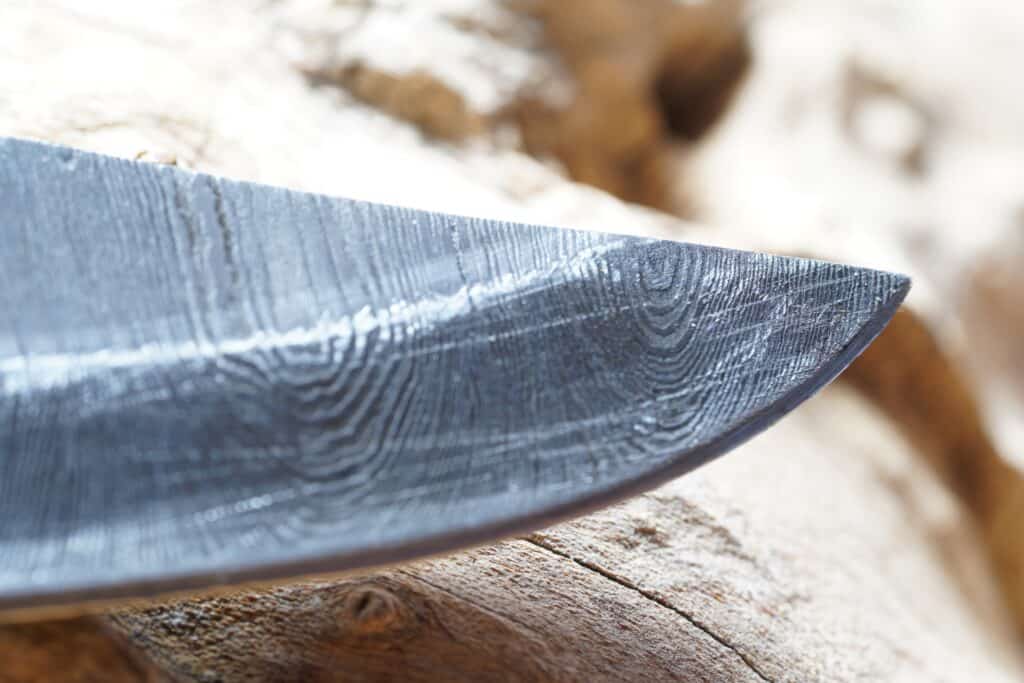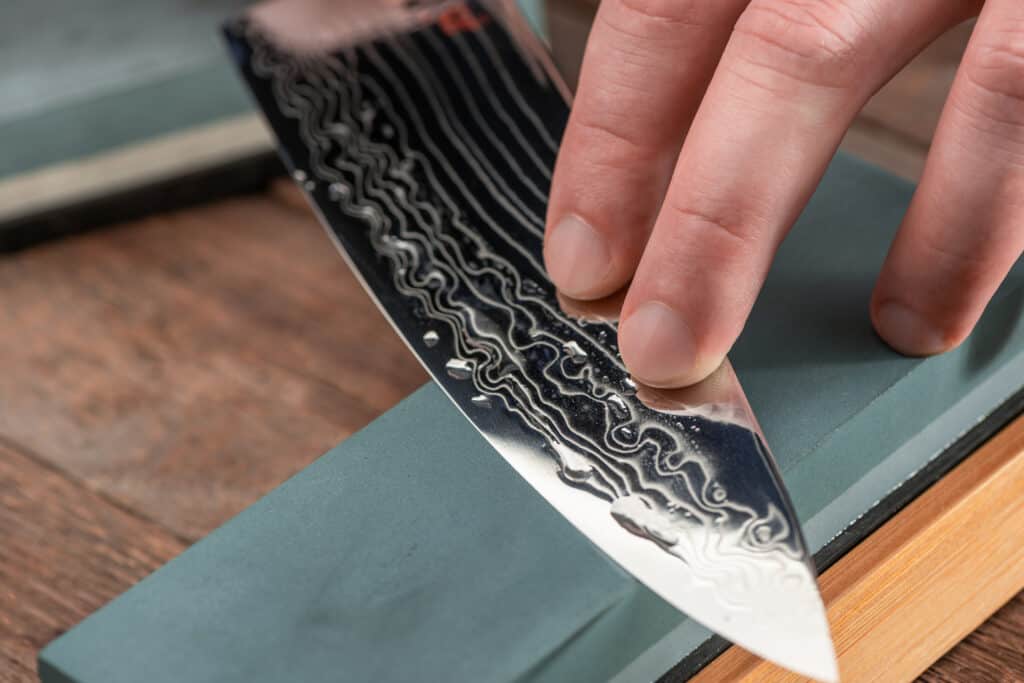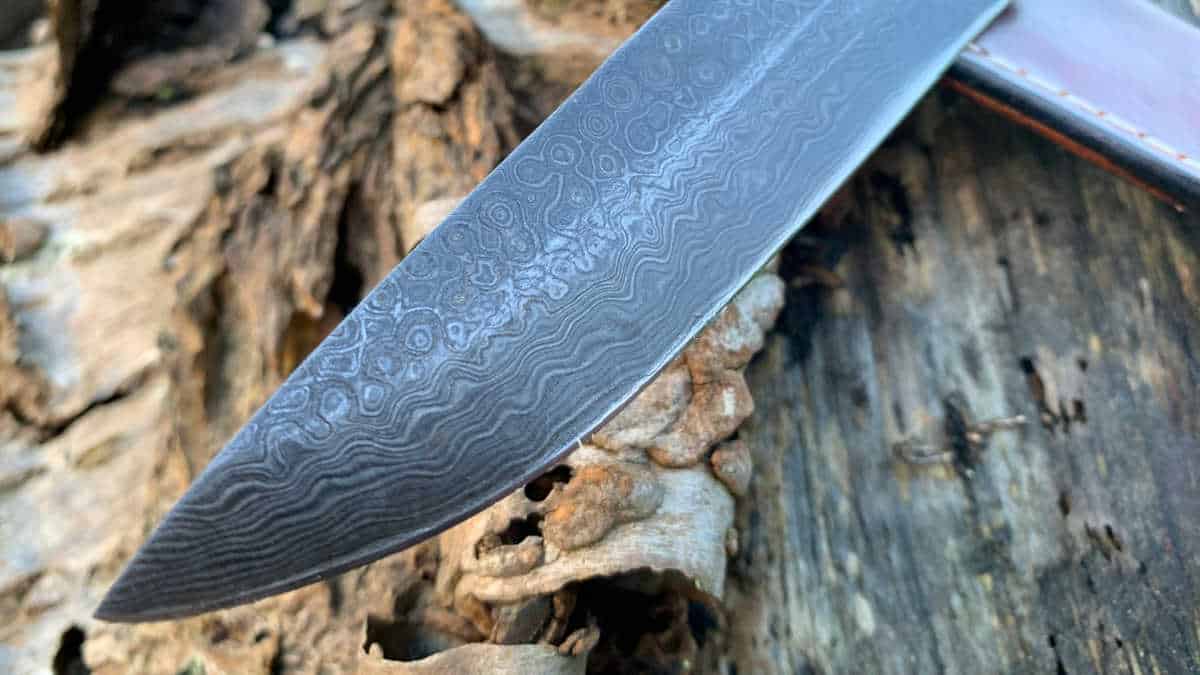As an Amazon Associate I earn from qualifying purchases.
I have been fascinated by Damascus knives for a long time. And I’m not alone.
The allure of Damascus steel has long captivated craftsmen and enthusiasts alike with its unique patterns reminiscent of flowing water.
Yet, with its growing popularity in the knife market, distinguishing a real Damascus knife from a cleverly crafted imitation has become a tricky endeavor. This article is dedicated to helping you navigate this challenging task. We’ll delve into the rich history of Damascus steel, discuss its defining characteristics, and provide practical steps to help you discern whether your knife truly hails from this ancient forging tradition or is simply an effective forgery.
Equipped with this knowledge, you’ll become a more informed collector or user of these fascinating tools.
So, whether you’re a seasoned bladesmith, an avid knife collector, or simply a curious enthusiast, join us as we cut through the mystery of authentic Damascus steel knives.
What Are Damascus Steel Knives?
Damascus steel, known to anyone with even an admiration of knives, exudes mystery, allure, and timeless craftsmanship. Dubbed after Syria’s capital city where it first made an appearance for sale, Damascus steel has long been distinguished by distinctive waterlike patterns on its surface – not simply as aesthetic qualities but indicative of an age-old metalworking process producing its distinctive structure and appearance.
Damascus steel was initially created via pattern welding. This technique involved forging different kinds of steel together, layering them, and folding them multiple times until folded multiple times into an accordion pattern. As a result, hard steel provided a sharp durability edge while flexible toughness. Following folding and forging processes, acid would then etch into its surface, giving rise to its iconic Damascus patterning.
Damascus steel, typically associated with knifemaking, can be formed using several distinct processes and materials; these vary largely. Modern Damascus is typically composed of two kinds of stainless steel that have been folded together via pattern welding to produce its distinctive multilayered effect.
Why Are Damascus Steel Knives Popular?

People are drawn to Damascus Steel for various reasons. From a practical viewpoint, its combination of hard and soft steels offers the right balance of sharpness, durability, and flexibility; but its real attraction lies in its aesthetic beauty – its distinct patterning gives each knife an individual identity, giving each tool more character than simply being another tool – thus turning Damascus steel into works of art for many knife enthusiasts and collectors. It has even become sought-after material in creating high-end custom knives!
The popularity of Damascus steel knives is due to several reasons, one of them being their versatility. They are manufactured in varying forms, which include pocket knives, swords, fixed blades, and more. They generally use materials like stag, tiger leather, walnut, micarta wood, ram horn, and more. No matter what task is at hand, Damascus knives make great fits. You can use these knives to slice fruits, chop wood, and more.
Damascus steel knives are very functional as well as stylish. However, they also have an expensive price tag. So, when you buy a Damascus knife, you better make sure you’re buying a genuine one.
Is My Knife Real Damascus?
It is vital for every Damascus knife owner to ascertain whether it is made of real Damascus steel. Unfortunately, there are many fake Damascus knives out there, which can be disappointing. So, how do you know if you have a real Damascus knife?
There are some obvious signs that you can see to tell a real Damascus knife from a fake one. But before that, it is important to know that Damascus steel features two different manufacturing processes, which are – Wootz steel and pattern-welded steel.
Wootz Steel
Wootz steel is the first real Damascus steel, available since the third century. To make this version of Damascus steel, people melt pieces of steel and iron in a clay pot. Wootz steel had its origins in India. Over time, the skill of making Wootz steel was passed to the East. However, today, it is difficult to make a replica of the original Wootz steel because the steps to the original process are lost.
Pattern-Welded Steel

Pattern-welded steel is the modern Damascus steel because it is relatively more available. It is 99.9% more dominant than Wootz steel. This style may have been out of trend for some time, but now it’s back and more popular than ever. Thanks to Bill Moran, who brought pattern-welded steel knives to their former glory in the 1970s. It uses more than two types of steel to create pattern-welded steel. After that, with acid etching, the steel gets a wavy and curvy pattern like that of Wootz steel.
How To Recognize Fake Damascus Knives (4 Ways)
Damascus steel is an ancient metalworking technique that produces unique patterns on the blade, making it highly sought after by knife collectors and enthusiasts. However, with the growing popularity of Damascus steel, many unscrupulous manufacturers are creating fake Damascus steel knives that do not have the same quality or characteristics as genuine ones. If you’re in the market for a Damascus steel knife, it’s essential to know how to differentiate a real one from a fake one. Here are some key factors to consider:
1. Look for a pattern on the blade
One of the most recognizable features of a genuine Damascus steel knife is the pattern on the blade. True Damascus steel is made by forge-welding multiple layers of steel together and then etching the blade in acid to bring out the unique pattern. This pattern is typically a swirling, wavy, or ladder-like design that is both beautiful and functional. Fake Damascus steel knives may have a pattern that has been stamped or laser-etched onto the blade, but it will not have the same depth, complexity, or beauty as a real Damascus steel pattern.
2. Check the blade for hardness
Another important characteristic of Damascus steel is its hardness. Genuine Damascus steel is known for being tough, durable, and able to hold a sharp edge for a long time. One way to test the hardness of a blade is to check its Rockwell hardness rating. A genuine Damascus steel knife will have a Rockwell rating of around 58-62, which is harder than most other types of steel. Fake Damascus steel knives may have a lower Rockwell rating, making them less durable and less likely to hold a sharp edge.
3. Inspect the blade for layers

The layers of steel in a genuine Damascus steel knife are what give it its unique pattern and strength. The more layers of steel that have been forge-welded together, the stronger and more durable the blade will be. A fake Damascus steel knife may have only a few layers of steel or may not be made from forge-welded steel at all. You can inspect the blade by looking at the edge or by examining the surface of the blade under a magnifying glass. Genuine Damascus steel will have a visible pattern of multiple layers of steel.
4. Consider the price
Genuine Damascus steel knives are often more expensive than fake ones because of the time, effort, and skill required to make them. If a Damascus steel knife seems too cheap to be true, it probably is. Be wary of knives that are priced significantly lower than other Damascus steel knives on the market. While there are some bargains to be found, a knife that is priced too low may be a fake.
Conclusion
When it comes to buying a Damascus steel knife, it’s important to do your research and make an informed decision. Look for a genuine pattern on the blade, check the Rockwell hardness rating, inspect the layers of steel in the blade, and consider the price. By following these tips, you can be confident that you are buying a real Damascus steel knife that will provide beauty, durability, and functionality for years to come.
Do Sheepsfoot Blades Have A Purpose? (Cuz They’re Ugly…)
Spetsnaz Machetes – Blades Of The Russian Special Forces
What Is The Actual Purpose Of A Spear Point Knife Blade?
CRKT CEO Review – Coolest, Most Worthless Knife Ever?
How Sharp Is A Scalpel? (Is It Sharper Than A Razor?)
Can You Shave With A Knife? (Yes, Here’s How)
As an Amazon Associate I earn from qualifying purchases.







